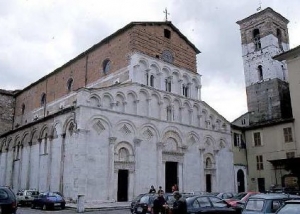
Information
Address:
Piazza Santa Maria Foris Portam, 55100 Lucca
Foundation:
VIII century
District/Location:
Lucca
District:
Piana di Lucca


This church, in the eastern part of the town beyond the roman walls, was first recorded in the 8th century and rebuilt before the 13th century. Some medieval features are still recognizable both in the structure and furnishings, although the church was greatly altered between the 16th and the 18th century. Most of the paintings date to this period, including two by Guercino and many other important works.
Santa Maria Forisportam, detta Santa Maria Bianca
The church, also known as S. Maria Bianca – due to its white limestone decoration - was first recorded in a document from the archiepiscopal archive dated to 768. The name Forisportam derives from its being outside the old roman walls, near the eastern gate.
The present building dates towards the second half of the 12th century and boasted the biggest known basilican crypt in the whole of Lucca, occupying the entire space of the cross and wings of the transept. In a bad state of ruin, it was entrusted to the Regular Canons of S. Agostino of the Congregation of S. Salvatore in 1512, which started its renovation in 1516, thanks to a considerable donation from Giovanni Guinigi. The crypt was demolished and the entire building was made higher and covered with cross vaults. The addition is clearly visible on the exterior given that it was built using brick and irregular ashlar masonry.
The alterations brought about the dismemberment of the rich presbyterial medieval ornament, which presumably included the lions built into the slopes of the façade, now on display at the Diocese Museum and replaced on site by copies. From the same complex there is also a stone slab with the Virgin on the Throne, a large fragment of the balustrade of the gallery housed in the National Museum of Villa Guinigi and other pieces displayed in public and private collections in Italy and abroad. Additional restorations of the Church are documented in 1721 and 1836.
The 16th century renovations also involved modification and embellishment, continued over time, of the altars’ dressing. A new high-altar was founded by Vincenzo Civitali in 1595, which was modified again in 1740 and received a new altar table in 1889, designed by Pietro Davini.
Among the works from this phase, particular interest is roused by two paintings by Guercino, a Santa Lucia and an Assunta, but also worth noting is the Trinity with Saints Francesco and Girolamo by Alessandro Ardenti, author of another piece originally belonging to this Church and now held at the Villa Guinigi Museum. The church also conserves remains of the original furnishings, including the central part of a polyptych by Angelo Puccinelli from 1386, traces of a 14th-15th century pattern that originally covered nearly all the walls and another interesting work, the Virgin and Child within in a lunette, whose recent restoration has allowed for verifying the influence held by the Sienese Martino di Bartolomeo. The confraternity of the SS. Sacramento have resided at the Church since the pastoral visit of 1575 to the present day. At that time the Confraternity of the Tintori was also present at the altar of S. Onofrio, while in 1422 this church was joined to the University of Pisans in Lucca.
The present building dates towards the second half of the 12th century and boasted the biggest known basilican crypt in the whole of Lucca, occupying the entire space of the cross and wings of the transept. In a bad state of ruin, it was entrusted to the Regular Canons of S. Agostino of the Congregation of S. Salvatore in 1512, which started its renovation in 1516, thanks to a considerable donation from Giovanni Guinigi. The crypt was demolished and the entire building was made higher and covered with cross vaults. The addition is clearly visible on the exterior given that it was built using brick and irregular ashlar masonry.
The alterations brought about the dismemberment of the rich presbyterial medieval ornament, which presumably included the lions built into the slopes of the façade, now on display at the Diocese Museum and replaced on site by copies. From the same complex there is also a stone slab with the Virgin on the Throne, a large fragment of the balustrade of the gallery housed in the National Museum of Villa Guinigi and other pieces displayed in public and private collections in Italy and abroad. Additional restorations of the Church are documented in 1721 and 1836.
The 16th century renovations also involved modification and embellishment, continued over time, of the altars’ dressing. A new high-altar was founded by Vincenzo Civitali in 1595, which was modified again in 1740 and received a new altar table in 1889, designed by Pietro Davini.
Among the works from this phase, particular interest is roused by two paintings by Guercino, a Santa Lucia and an Assunta, but also worth noting is the Trinity with Saints Francesco and Girolamo by Alessandro Ardenti, author of another piece originally belonging to this Church and now held at the Villa Guinigi Museum. The church also conserves remains of the original furnishings, including the central part of a polyptych by Angelo Puccinelli from 1386, traces of a 14th-15th century pattern that originally covered nearly all the walls and another interesting work, the Virgin and Child within in a lunette, whose recent restoration has allowed for verifying the influence held by the Sienese Martino di Bartolomeo. The confraternity of the SS. Sacramento have resided at the Church since the pastoral visit of 1575 to the present day. At that time the Confraternity of the Tintori was also present at the altar of S. Onofrio, while in 1422 this church was joined to the University of Pisans in Lucca.
Scopri altre attrazioni vicino a S. Maria Forisportam known as S. M. Bianca
See allYou may also like..
See allFind more
0











